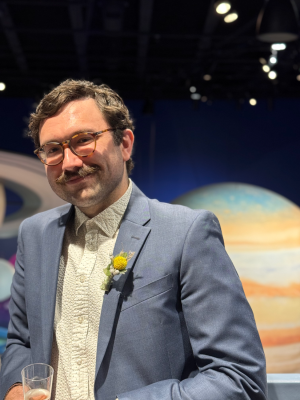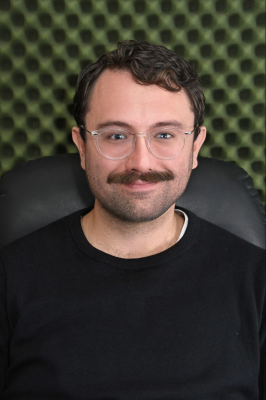Theodore Kareta, PhD
Assistant Professor of Astrophysics & Planetary Science Villanova University
- Villanova PA
Professor Kareta, Ph.D., researches comets, asteroids and other small solar system bodies with telescopes, computer models and spacecraft.
Areas of Expertise
Biography
Prior to joining Villanova, Dr. Kareta worked as a postdoctoral research associate at Lowell Observatory in Flagstaff, Arizona where he played a key role in NASA's first planetary defense mission, the Double Asteroid Redirection Test or DART. He has also was a part of the science teams for the NASA OSIRIS-REx mission and the European Space Agency (ESA)'s mission Rosetta. Throughout both his telescopic and spacecraft-related work, Dr. Kareta has successfully involved many students meaningfully in his research.
Dr. Kareta's research has increasingly focused on the study of the Interstellar Objects, comets and asteroids which formed around other stars before being tossed out and subsequently found rapidly passing through our own Solar System. He lead some of the earliest publications detailing ground-based telescopic characterizations of both the second and third of the interstellar objects, 2I/Borisov and 3I/ATLAS, and has been funded by NASA to study near-Earth object analogues to the Interstellar Objects closer to home.
From 2021 to 2025, Dr. Kareta was also the press officer for the American Astronomical Society's Division for Planetary Sciences. He maintains both an interest in and a commitment to thorough and effective communication of science to the public through all possible channels.
Education
University of Arizona
PhD
Planetary Science
UMass Amherst
BS
Physics and Astronomy
Affiliations
- American Astronomical Society's Division for Planetary Science (DPS) : Junior/Member, 2018 - Present
Select Media Appearances
Astronomers discover previously unknown quasi-moon near Earth
CNN online
2025-10-22
“Based on what little we know so far, it’s almost certainly a rocky and natural object — sometimes old satellites and rocket junk end up in these very-near-Earth kinds of orbits, but we can often tell ‘natural’ (e.g., asteroidal) from ‘artificial’ (e.g., satellite) based on how their orbits evolve on short timescales,” wrote Dr. Teddy Kareta, assistant professor in the department of astrophysics and planetary science at Villanova University, in an email.
Comet Lemmon will appear in the Philly-area skies the next several evenings
The Philadelphia Inquirer print
2025-10-18
Come Monday around sunset, Teddy Kareta plans to ascend to the roof of a building near Lancaster Avenue on the Main Line to catch sight of something in the evening sky that hasn’t been around for about 1,300 years.
To the surprise of astronomers, a “cosmic snowball” named Comet Lemmon has become so bright “that people don’t have to be in the most perfect dark location” to see it, said Kareta, assistant professor of astrophysics and planetary science at Villanova University.
Astronomers spot an interstellar object zipping through our solar system
CNN online
2025-07-03
The comet is moving at nearly 37 miles per second (60 kilometers per second) — or 133,200 miles per hour (about 214,364 kilometers per hour) — too fast to be a “local” object in our solar system, said Teddy Kareta, an assistant professor at Villanova University near Philadelphia.
Earth’s Mini-Moon Was Probably a Piece of Its Real Moon
The New York Times online
2025-01-23
“We knew that lunar ejecta were potentially hiding in these kinds of really near-Earth orbits,” said Teddy Kareta, a postdoctoral researcher at Lowell Observatory in Arizona who led the research.
'It's like taking a picture of lightning': How astronomers raced to track the smallest asteroid ever seen
Space.com online
2024-12-05
"Without question, it was the most exciting hour of my job that I’ve ever had," Kareta, a postdoctoral researcher at Lowell Observatory, told Space.com in a recent interview. "In some sense, we ended up getting a world-quality dataset on a fundamentally extremely common phenomenon."
The moon will get a temporary sidekick. It's called a mini-moon but it's an asteroid
NPR radio
2024-09-24
Yes, it's being called a mini-moon. It is expected to orbit the Earth for about two months from this Sunday through Thanksgiving.
INSKEEP: But that's no moon, as Teddy Kareta with the Lowell Observatory in Flagstaff, Ariz., explains.
The real science behind the mysterious 'Devil Comet' that's larger than Mount Everest and erupting for reasons scientists don't fully understand
Business Insider online
2023-10-21
Typically, comets are between 0.6 and 1.8 miles wide, according to Teddy Kareta, a postdoctoral researcher at Lowell Observatory in Flagstaff, Arizona.
"We know it's big. We know it's an outlier. We know it's rare," Kareta told Insider.
Research Grants
Shining a Light on the Dark Comets
Yearly Opportunities in Planetary Defense (YORPD), NASA
2025 - 2028
Select Academic Articles
Near-discovery Observations of Interstellar Comet 3I/ATLAS with the NASA Infrared Telescope Facility
The Astrophysical Journal Letters2025
Telescope-to-Fireball Characterization of Earth Impactor 2022 WJ1
The Planetary Science Journal2024
Ejecta Evolution Following a Planned Impact into an Asteroid: The First Five Weeks
The Astrophysical Journal Letters2023
Contemporaneous Multiwavelength and Precovery Observations of the Active Centaur P/2019 LD2 (ATLAS)
The Planetary Science Journal2021




